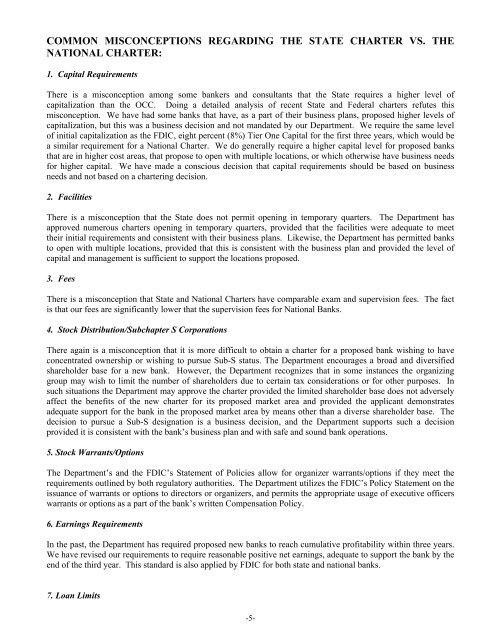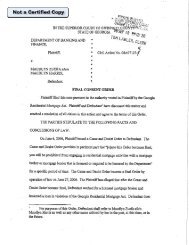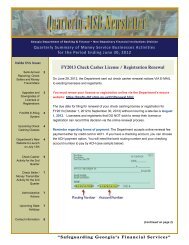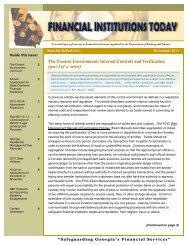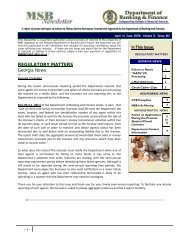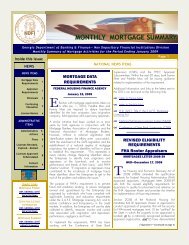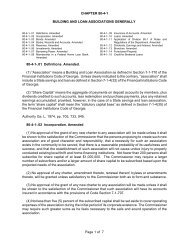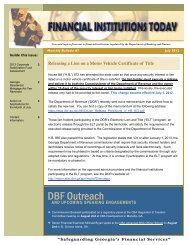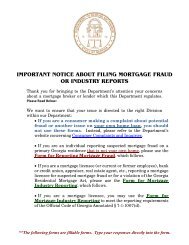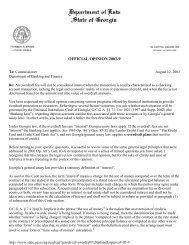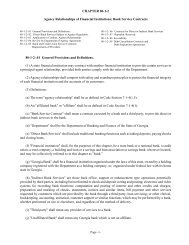facts about chartering a state-chartered bank - Department of ...
facts about chartering a state-chartered bank - Department of ...
facts about chartering a state-chartered bank - Department of ...
Create successful ePaper yourself
Turn your PDF publications into a flip-book with our unique Google optimized e-Paper software.
COMMON MISCONCEPTIONS REGARDING THE STATE CHARTER VS. THE<br />
NATIONAL CHARTER:<br />
1. Capital Requirements<br />
There is a misconception among some <strong>bank</strong>ers and consultants that the State requires a higher level <strong>of</strong><br />
capitalization than the OCC. Doing a detailed analysis <strong>of</strong> recent State and Federal charters refutes this<br />
misconception. We have had some <strong>bank</strong>s that have, as a part <strong>of</strong> their business plans, proposed higher levels <strong>of</strong><br />
capitalization, but this was a business decision and not mandated by our <strong>Department</strong>. We require the same level<br />
<strong>of</strong> initial capitalization as the FDIC, eight percent (8%) Tier One Capital for the first three years, which would be<br />
a similar requirement for a National Charter. We do generally require a higher capital level for proposed <strong>bank</strong>s<br />
that are in higher cost areas, that propose to open with multiple locations, or which otherwise have business needs<br />
for higher capital. We have made a conscious decision that capital requirements should be based on business<br />
needs and not based on a <strong>chartering</strong> decision.<br />
2. Facilities<br />
There is a misconception that the State does not permit opening in temporary quarters. The <strong>Department</strong> has<br />
approved numerous charters opening in temporary quarters, provided that the facilities were adequate to meet<br />
their initial requirements and consistent with their business plans. Likewise, the <strong>Department</strong> has permitted <strong>bank</strong>s<br />
to open with multiple locations, provided that this is consistent with the business plan and provided the level <strong>of</strong><br />
capital and management is sufficient to support the locations proposed.<br />
3. Fees<br />
There is a misconception that State and National Charters have comparable exam and supervision fees. The fact<br />
is that our fees are significantly lower that the supervision fees for National Banks.<br />
4. Stock Distribution/Subchapter S Corporations<br />
There again is a misconception that it is more difficult to obtain a charter for a proposed <strong>bank</strong> wishing to have<br />
concentrated ownership or wishing to pursue Sub-S status. The <strong>Department</strong> encourages a broad and diversified<br />
shareholder base for a new <strong>bank</strong>. However, the <strong>Department</strong> recognizes that in some instances the organizing<br />
group may wish to limit the number <strong>of</strong> shareholders due to certain tax considerations or for other purposes. In<br />
such situations the <strong>Department</strong> may approve the charter provided the limited shareholder base does not adversely<br />
affect the benefits <strong>of</strong> the new charter for its proposed market area and provided the applicant demonstrates<br />
adequate support for the <strong>bank</strong> in the proposed market area by means other than a diverse shareholder base. The<br />
decision to pursue a Sub-S designation is a business decision, and the <strong>Department</strong> supports such a decision<br />
provided it is consistent with the <strong>bank</strong>’s business plan and with safe and sound <strong>bank</strong> operations.<br />
5. Stock Warrants/Options<br />
The <strong>Department</strong>’s and the FDIC’s Statement <strong>of</strong> Policies allow for organizer warrants/options if they meet the<br />
requirements outlined by both regulatory authorities. The <strong>Department</strong> utilizes the FDIC’s Policy Statement on the<br />
issuance <strong>of</strong> warrants or options to directors or organizers, and permits the appropriate usage <strong>of</strong> executive <strong>of</strong>ficers<br />
warrants or options as a part <strong>of</strong> the <strong>bank</strong>’s written Compensation Policy.<br />
6. Earnings Requirements<br />
In the past, the <strong>Department</strong> has required proposed new <strong>bank</strong>s to reach cumulative pr<strong>of</strong>itability within three years.<br />
We have revised our requirements to require reasonable positive net earnings, adequate to support the <strong>bank</strong> by the<br />
end <strong>of</strong> the third year. This standard is also applied by FDIC for both <strong>state</strong> and national <strong>bank</strong>s.<br />
7. Loan Limits<br />
-5-


